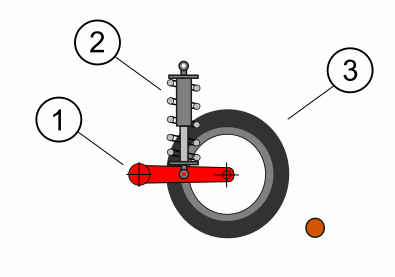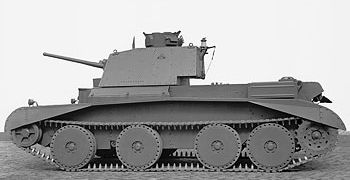|
A-13 (tank)
The A-13 was a specification of British Cruiser tanks produced by the General Staff Directorate of Tank Design before and during the Second World War. The A13 specification was produced prior to the second world war, calling for the development of a new cruiser tank. This was the first specification of British cruiser tank to be based on the Christie suspension design. The specification was revised over time, and lead to the development of three different vehicles: *A13 Mark I produced the Cruiser Mk III based on the original specification; *A13 Mark II produced the Cruiser Mk IV a revision based on up-armouring of the original specification; *A13 Mark III produced the Covenanter tank The Cruiser tank Mk V or A13 Mk III Covenanter was a British cruiser tank of the Second World War. The Covenanter was the first cruiser tank design to be given a name. Designed by the London, Midland and Scottish Railway as a better-armoured rep ... based on the final version, a comple ... [...More Info...] [...Related Items...] OR: [Wikipedia] [Google] [Baidu] |
Cruiser Tank
The cruiser tank (sometimes called cavalry tank or fast tank) was a British tank concept of the interwar period for tanks designed as modernised armoured and mechanised cavalry, as distinguished from infantry tanks. Cruiser tanks were developed after medium tank designs of the 1930s failed to satisfy the Royal Armoured Corps. The cruiser tank concept was conceived by Giffard Le Quesne Martel, who preferred many small light tanks to swarm an opponent, instead of a few expensive and unsatisfactory medium tanks. "Light" cruiser tanks (for example the Cruiser Mk I) carried less armour and were correspondingly faster, whilst "heavy" cruiser tanks (such as the Cruiser Mk II) had more armour and were slightly slower. The British cruiser tank series started in 1938 with the A9 and A10 cruiser tanks, followed by the A13, A13 Mark II, the A13 Mark III Covenanter in 1940 and the A15 Crusader which entered service in 1941. The Crusader was superseded by the A27 Cromwell in 1944. The A ... [...More Info...] [...Related Items...] OR: [Wikipedia] [Google] [Baidu] |
General Staff
A military staff or general staff (also referred to as army staff, navy staff, or air staff within the individual services) is a group of officers, enlisted and civilian staff who serve the commander of a division or other large military unit in their command and control role through planning, analysis, and information gathering, as well as by relaying, coordinating, and supervising the execution of their plans and orders, especially in case of multiple simultaneous and rapidly changing complex operations. They are organised into functional groups such as administration, logistics, operations, intelligence, training, etc. They provide multi-directional flow of information between a commanding officer, subordinate military units and other stakeholders.PK Mallick, 2011Staff System in the Indian Army: Time for Change Centre for Land Warfare Studies, New Delhi, vol 31. A centralised general staff results in tighter top-down control but requires larger staff at headquarters (HQ) ... [...More Info...] [...Related Items...] OR: [Wikipedia] [Google] [Baidu] |
Cruiser Tank
The cruiser tank (sometimes called cavalry tank or fast tank) was a British tank concept of the interwar period for tanks designed as modernised armoured and mechanised cavalry, as distinguished from infantry tanks. Cruiser tanks were developed after medium tank designs of the 1930s failed to satisfy the Royal Armoured Corps. The cruiser tank concept was conceived by Giffard Le Quesne Martel, who preferred many small light tanks to swarm an opponent, instead of a few expensive and unsatisfactory medium tanks. "Light" cruiser tanks (for example the Cruiser Mk I) carried less armour and were correspondingly faster, whilst "heavy" cruiser tanks (such as the Cruiser Mk II) had more armour and were slightly slower. The British cruiser tank series started in 1938 with the A9 and A10 cruiser tanks, followed by the A13, A13 Mark II, the A13 Mark III Covenanter in 1940 and the A15 Crusader which entered service in 1941. The Crusader was superseded by the A27 Cromwell in 1944. The A ... [...More Info...] [...Related Items...] OR: [Wikipedia] [Google] [Baidu] |
Christie Suspension
The Christie suspension is a suspension system developed by American engineer J. Walter Christie for his tank designs. It allowed considerably longer movement than conventional leaf spring systems then in common use, which allowed his tanks to have considerably greater cross-country speed. The system was first introduced on his M1928 design, and used on all of his designs until his death in 1944. History Christie advocated the use of lightweight tanks with long range and high speed, designed to penetrate enemy lines and attack their infrastructure and logistics capabilities. A major problem with tanks in World War I was tracked suspension failure. Christie's first tank design of 1919 could be driven on its wheels to get to the starting point and then the tracks fitted before it went into action. The US Tank Corps ordered a single tank from Christie's company based on this design. The tank, known as the M1919, was delivered in early 1921 and tested until Christie proposed ... [...More Info...] [...Related Items...] OR: [Wikipedia] [Google] [Baidu] |
Cruiser Mk III
The Tank, Cruiser, Mk III, also known by its General Staff specification number A13 Mark I, was a British cruiser tank of the Second World War. It was the first British cruiser tank to use the Christie suspension system, which gave higher speeds and better cross-country performance; previous cruiser tank models had used triple wheeled bogie suspension. Design and development British cruiser tank design began with the Mk I and somewhat heavier Mk II in the mid-1930s. Just as prototypes were arriving in 1936, General Giffard LeQuesne Martel, a pioneer in tank design who had published works on armoured warfare and pioneered the lightly armoured "tankette" to enhance infantry mobility, became Assistant Director of Mechanization at the War Office.Milsom Later that year, Martel witnessed demonstrations of Soviet tank designs, including the BT tank, which had been influenced by American J. Walter Christie's work. Martel urged the adoption of the Christie suspension and Christie's pra ... [...More Info...] [...Related Items...] OR: [Wikipedia] [Google] [Baidu] |
Cruiser Mk IV
} The Cruiser Tank Mk IV ( A13 Mk II) was a British cruiser tank of the Second World War. It followed directly on from the Tank, Cruiser, Mk III (A13 Mk I). The first Mk IVs were Mk IIIs with extra armour fitted to the turret. Later Mk IVAs were built with the complete extra armour. The tank was used in France in 1940 and in the early part of the war in North Africa, before being withdrawn from service. A fast vehicle compared to other British tanks of the early part of the war, it was probably the best tank Britain had in 1940. In total, 955 of these tanks were built. Design and development Britain became interested in fast tanks after observing the Soviet BT tanks during the 1936 Red Army manoeuvres. The BT was based on the revolutionary designs of American J. Walter Christie and a team from Morris Motors was sent to the United States to purchase a Christie tank and the rights to build more. The tank was given the General Staff designation "A13E1" and was delivered in late 1 ... [...More Info...] [...Related Items...] OR: [Wikipedia] [Google] [Baidu] |
Covenanter Tank
The Cruiser tank Mk V or A13 Mk III Covenanter was a British cruiser tank of the Second World War. The Covenanter was the first cruiser tank design to be given a name. Designed by the London, Midland and Scottish Railway as a better-armoured replacement for the Cruiser Mark IV, it was ordered into production in 1939 before pilot models were built. Problems with the design became apparent only after production was under way. The tank equipped various British armoured divisions for home defence and training. It never left the UK as poor engine cooling caused the Mk I to Mk III to be declared unfit for overseas service especially in hot climates. This was rectified in the Mk IV after many corrective actions were undertaken but, by February 1944, it was declared obsolete. More than 1,700 of the type were built. It was named after the Covenanters, a Scottish religious faction at the time of the Wars of the Three Kingdoms. Development In 1938, the War Office had issued a requireme ... [...More Info...] [...Related Items...] OR: [Wikipedia] [Google] [Baidu] |
Tanks Of The United Kingdom
These are lists of UK tanks to enable cross-referencing between the design names and the service names. General Staff numbers This is a list of UK tanks up to the end of the Second World War that received designations starting with the letter "A" - these would be designs requested by the General Staff to meet specifications issued, as opposed to private venture designs submitted by manufacturers to the General Staff *Did not enter service Alphabetical lists Includes the C names * Caernarvon * Centurion * Challenger * Challenger 1 * Challenger 2Challenger 3 * Charioteer * Chieftain * Churchill * Comet * Conqueror * Contentious * Conway * Covenanter * Cromwell * Crusader * Light Tank Mk VI * Matilda I * Matilda II * Medium Tank A/T 1 - an amphibious tank prototype * TOG 1 * TOG 2 * Valentine See also * List of FV series military vehicles - Covers post-1945 UK tanks with other vehicles * British armoured fighting vehicle production during World War II * Light tanks o ... [...More Info...] [...Related Items...] OR: [Wikipedia] [Google] [Baidu] |





_front-left_2017_Bovington.jpg)